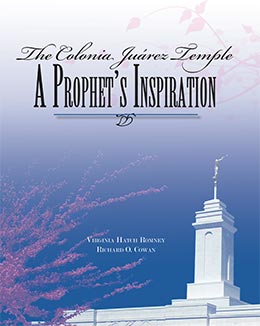Appendix C
President Hinckley's General Conference Announcement
Virginia Hatch Romney and Richard O. Cowan, The Colonia Juárez Temple: A Prophet’s Inspiration (Provo, UT: Religious Studies Center, Brigham Young University, 2009), 193-5.
I believe that no member of the Church has received the ultimate which this Church has to give until he or she has received his or her temple blessings in the house of the Lord. Accordingly, we are doing all that we know how to do to expedite the construction of these sacred buildings and make the blessings received therein more generally available.
With the dedication of the St. Louis Temple last June, we have 50 working temples. We will soon dedicate the Vernal Utah Temple. The next dedication is scheduled for June of 1998 in Preston, England.
I am pleased to report that the temples in Colombia; Ecuador; the Dominican Republic; Bolivia; Spain; Recife and Campinas, Brazil; Mexico; Boston; New York; and Albuquerque are all moving forward either in planning or in various stages of construction. Our previously announced plan to construct a temple in Venezuela is also going forward, and we are hopeful of acquiring a site in the very near future. We continue to work on permits of various kinds, against some opposition, for temples in Billings, Montana; and Nashville, Tennessee.
I am now pleased to announce our intent to build temples in Houston, Texas; and in Pôrto Alegre, Brazil. All of this speaks of our great interest in vigorously moving forward this important work. Altogether I think we have about 17 temples in some course of construction, and that is a prodigious undertaking.
Small temples will be built
But there are many areas of the Church that are remote, where the membership is small and not likely to grow very much in the near future. Are those who live in these places to be denied forever the blessings of the temple ordinances? While visiting such an area a few months ago, we prayerfully pondered this question. The answer, we believe, came bright and clear.
We will construct small temples in some of these areas, buildings with all of the facilities to administer all of the ordinances. They would be built to temple standards, which are much higher than meetinghouse standards. They would accommodate baptisms for the dead, the endowment service, sealings, and all other ordinances to be had in the Lord’s house for both the living and the dead.
They would be presided over, wherever possible, by local men called as temple presidents, just as stake presidents are called. They would have an indefinite period of appointment. They would live in the area, in their own homes. One counselor would serve as temple recorder, the other as temple engineer. All ordinance workers would be local people who would serve in other capacities in their wards and stakes.
Patrons would be expected to have their own temple clothing, thereby making unnecessary the construction of very costly laundries. A simple laundry would take care of baptismal clothing. There would be no eating facilities.
These structures would be open according to need, maybe only one or two days a week—that would be left to the judgment of the temple president. Where possible, we would place such a building on the same grounds as the stake center, using the same parking lot for both facilities, thereby effecting a great savings.
One of these small temples can be constructed for about the same cost it takes just to maintain a large temple for a single year. It can be constructed in a relatively short time, several months. I repeat that none of the essentials would be missing. Every ordinance performed in the house of the Lord would be available. These small buildings would have at least half the capacity of some of our much larger temples. They could be expanded when needed.
Now as you hear me say these things, I think stake presidents in many areas will say this is exactly what we need. Well, let us know of your needs, and we will give them prayerful and careful consideration, but please don’t expect things to happen all at once. We need a little experience for this undertaking.
The operation of such temples will require some measure of sacrifice on the part of our faithful local Saints. They not only will serve as ordinance workers; it will be expected that they will clean the buildings and take care of them. But the burden will not be heavy; in view of the blessings, it will be light indeed. There will be no paid employees; all of the work of operation will represent faith and devotion and dedication.
We are planning such structures immediately in Anchorage, Alaska; in the LDS colonies in northern Mexico; and in Monticello, Utah. In areas of greater Church membership we will build more of the traditional temples, but we are developing plans that will reduce the costs without any reduction in terms of the work to be performed therein. We are determined, brethren, to take the temples to the people and afford them every opportunity for the very precious blessings that come of temple worship. (in Conference Report, October 1997, 68–69)
